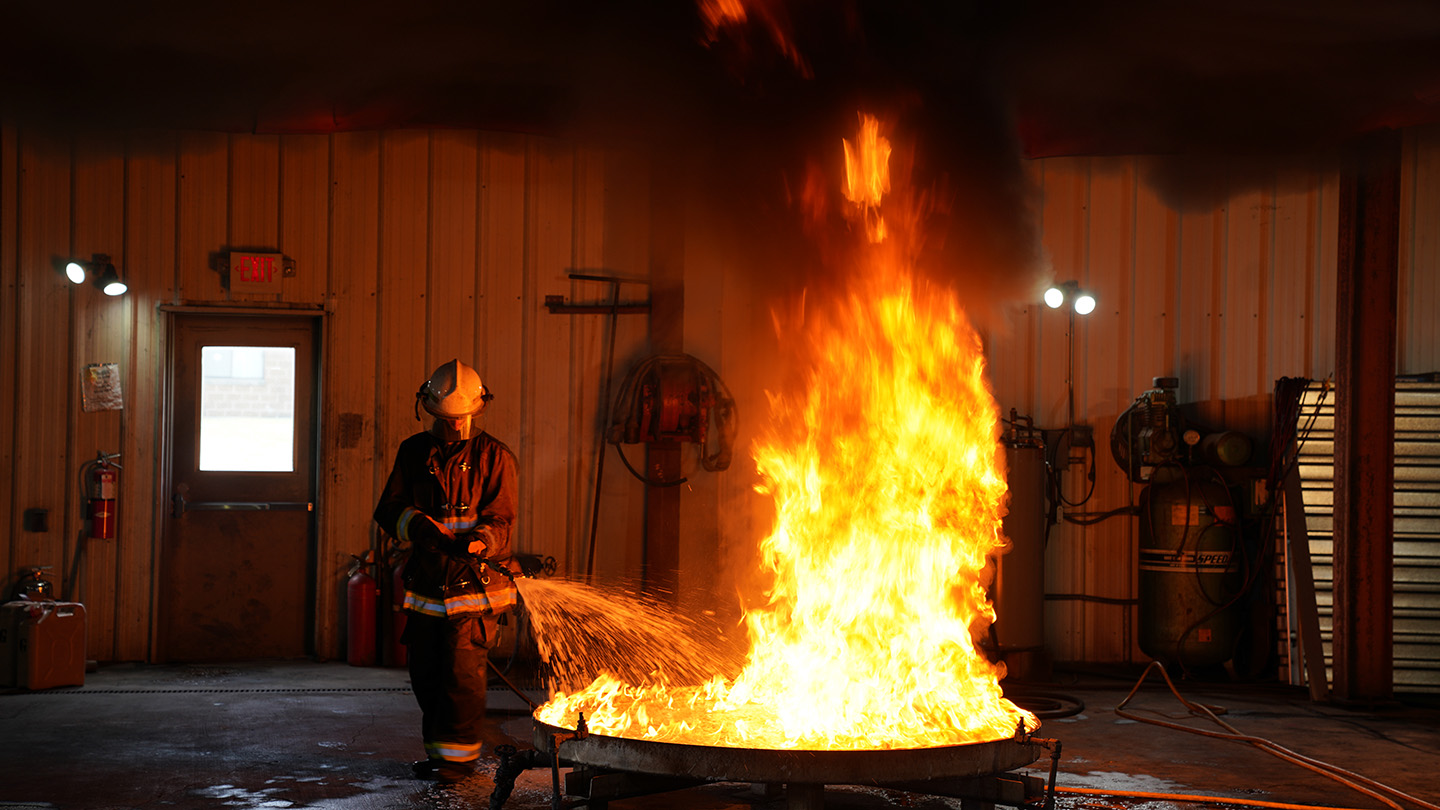Press Release
Johns Hopkins APL Explores Alternatives to PFAS in Firefighting Foams
In response to a new Department of Defense (DoD) mandate that is phasing out the purchase and use of PFAS-containing aqueous film forming foams (AFFF) for firefighting on military bases in 2024, researchers at the Johns Hopkins Applied Physics Laboratory (APL) in Laurel, Maryland, are testing and evaluating additives to enhance firefighting capabilities of commercially available PFAS-free fire suppressants for military use.
PFAS, short for perfluoroalkyl and polyfluoroalkyl substances, also known as “forever chemicals,” are complex, long-lasting chemicals found in many household products. They also produce the film component of the AFFF used by the military.
“The firefighting foams used by the military must be able to extinguish Class B fires, which involve flammable and combustible liquids like gasoline, alcohol or oil-based paints,” explained Danielle Nachman, a geochemist at APL and principal investigator on this study. “The carbon-fluorine bonds that we see in PFAS are some of the strongest bonds we know of in chemistry, and they’re really good at forming films and choking a fire out.”
The carbon-fluorine bonds in PFAS are so strong that the chemicals don’t degrade naturally in the environment. PFAS have been detected in water, air and soil around the world, and scientific studies have linked the chemicals to harmful effects on humans and animals.
An Urgent Problem
In 2019, the secretary of defense established a task force to investigate and coordinate the DoD’s PFAS remediation efforts. The task force identified more than 700 active military locations where PFAS may have leaked into the soil or groundwater, and it is actively cleaning up and looking for AFFF alternatives. APL was selected by the Strategic Environmental Research and Development Program, which seeks research to improve the DoD’s environmental performance, to further study additives to be incorporated into PFAS-free firefighting foams.
“The DoD is looking to solve this problem quickly,” Nachman said. “The PFAS-free foams that are on the market right now do not meet military requirements for the legacy AFFF, so we’re urgently searching for different chemical components to add to their formulations that will make them more effective.”
A majority of these efforts throughout the industry are targeted at developing entirely new formulations, but given the urgency, APL is searching for additives to existing formulations that can be deployed faster in the field. APL researchers discovered that octanol, an organic compound frequently found in perfumes and essential oils, and biochar, a charcoal-like residue produced from burning organic materials, improved firefighting capabilities in two PFAS-free foams, increasing performance in both time to extinguish and burn-back time — or how quickly the fire reignites after it’s extinguished.
The team started with laboratory experiments at APL, characterizing chemical properties of the foams such as viscosity and surface tension. They progressed to small-scale fire tests to verify the correlation between these variables and identify the most promising combinations of foams and additives. These mixtures were then tested in 28-square-foot field tests by collaborators at Jensen Hughes, a fire protection engineering firm with extensive expertise in assessing fire suppression. While the additives demonstrated significant improvement in the firefighting capabilities of the PFAS-free foams, they still don’t meet military specifications for legacy AFFF yet.
“This has been a really great step on our journey to develop and assess additives that can enhance performance of PFAS-free foams with the ultimate goal to meet and/or exceed the standards set by AFFF,” said Nachman. “It’s a significant challenge facing our country, and one we feel confident we can solve.”
APL’s PFAS Portfolio
As a trusted government agent, APL has decades of testing-and-evaluation expertise to rely on, in addition to a PFAS remediation portfolio, including the development of several PFAS filtration and destruction methodologies, each capable of destroying greater than 90% of PFAS in contaminated water.
“We’ve established capabilities to capture, destroy and remove these chemicals, and now we’re working on replacing them,” said Leslie Hamilton, a leader of APL’s Science of Extreme and Multifunctional Materials Program. “We’re not going to solve this problem with just one tactic; we need to approach it from every avenue possible.”
This material is based on work supported by the U.S. Army Corps of Engineers and the Department of Defense Strategic Environmental Research and Development Program under Contract No. W912HQ22P0049. Any opinions, findings and conclusions or recommendations expressed in this material are those of the author(s) and do not necessarily reflect the views, opinions or findings of the U.S. Army Corps of Engineers or the Department of Defense Strategic Environmental Research and Development Program or the Department of Defense.
